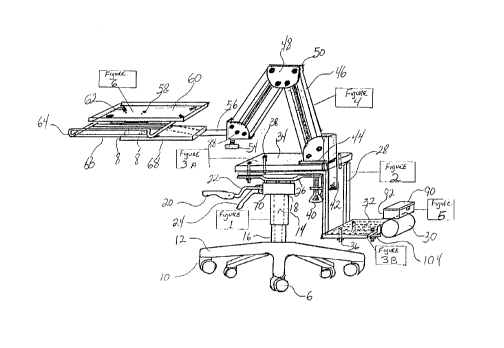Some of the information on this Web page has been provided by external sources. The Government of Canada is not responsible for the accuracy, reliability or currency of the information supplied by external sources. Users wishing to rely upon this information should consult directly with the source of the information. Content provided by external sources is not subject to official languages, privacy and accessibility requirements.
Any discrepancies in the text and image of the Claims and Abstract are due to differing posting times. Text of the Claims and Abstract are posted:
| (12) Patent Application: | (11) CA 2253978 |
|---|---|
| (54) English Title: | SPACE SAVER PORTABLE CONVENTIONAL HOME COMPUTER CARRIAGE |
| (54) French Title: | CHARIOT D'ORDINATEUR DOMESTIQUE, CLASSIQUE, PORTATIF, DE FAIBLE ENCOMBREMENT |
| Status: | Dead |
| (51) International Patent Classification (IPC): |
|
|---|---|
| (72) Inventors : |
|
| (73) Owners : |
|
| (71) Applicants : |
|
| (74) Agent: | |
| (74) Associate agent: | |
| (45) Issued: | |
| (22) Filed Date: | 1998-11-25 |
| (41) Open to Public Inspection: | 2000-05-25 |
| Availability of licence: | N/A |
| (25) Language of filing: | English |
| Patent Cooperation Treaty (PCT): | No |
|---|
| (30) Application Priority Data: | None |
|---|
This present invention is a space saver, portable, home computer carriage. The
upper embodiments consists of a floating metal platform to support a computer
monitor, a
keyboard rack and a rolling shelf under the keyboard rack for the mouse.
The computer platform is able to rotate 360°, also a rotating
mechanical arm
supports the platform and enables the monitor, keyboard and mouse shelf to be
transferred from side to side and front to back. The rotating mechanical arm
is secured
with a clamp system to a table.
On the opposite side of the table, a metal frame is secured. It is designed to
support a shelf to sit the computer tower off the ground. All these
embodiments are
secured counterbalanced onto a live leg rolling system which can be related to
the under
carriage of an office chair, consisting of a vertical locking cylinder device
which adjusts
manually to different heights and also rotate the whole system 360°.
Note: Claims are shown in the official language in which they were submitted.
Note: Descriptions are shown in the official language in which they were submitted.

For a clearer understanding of the status of the application/patent presented on this page, the site Disclaimer , as well as the definitions for Patent , Administrative Status , Maintenance Fee and Payment History should be consulted.
| Title | Date |
|---|---|
| Forecasted Issue Date | Unavailable |
| (22) Filed | 1998-11-25 |
| (41) Open to Public Inspection | 2000-05-25 |
| Dead Application | 2001-11-26 |
| Abandonment Date | Reason | Reinstatement Date |
|---|---|---|
| 2000-11-27 | FAILURE TO PAY APPLICATION MAINTENANCE FEE |
| Fee Type | Anniversary Year | Due Date | Amount Paid | Paid Date |
|---|---|---|---|---|
| Application Fee | $150.00 | 1998-11-25 |
Note: Records showing the ownership history in alphabetical order.
| Current Owners on Record |
|---|
| BOURDON, PASCAL MARCEL |
| Past Owners on Record |
|---|
| None |